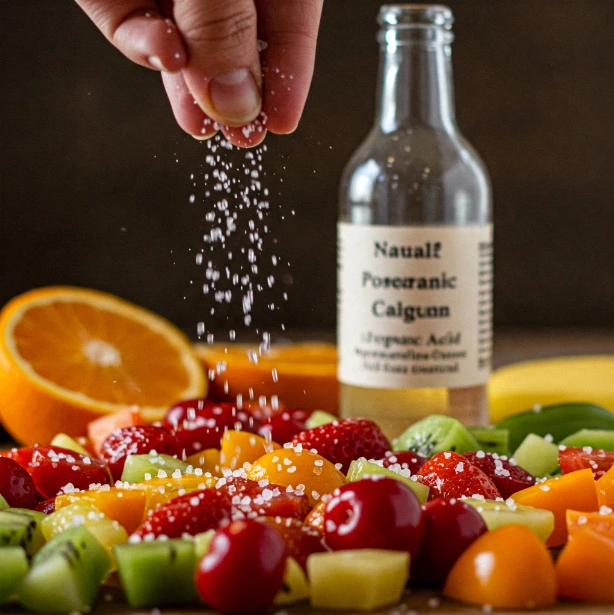ChatGPT said:
In modern food industries, the use of natural preservatives such as salt and organic acids to increase shelf life and food safety is common. On the surface, combining these two substances should have synergistic effects: salt acts as a water activity reducer, and acid lowers the pH of the environment, inhibiting bacterial growth. However, is this combination always effective? A recent study published in the Food Research International journal suggests that, in some cases, salt may reduce the bactericidal effects of acids—at least concerning the dangerous bacterium Escherichia coli O157:H7.
Introduction to E. coli O157:H7
This particular strain of E. coli, due to its production of Shiga toxin, is a serious cause of food poisoning. Symptoms range from mild diarrhea to kidney failure (especially in children and the elderly). The presence of this bacterium in undercooked meat, contaminated vegetables, and fermented products is a public health threat.
The Role of Organic Acids in Bacterial Control
Weak organic acids such as:
Acetic acid (in vinegar),
Lactic acid (in dairy and fermented products),
Citric acid (in citrus fruits),
Malic acid (in apples),
Tartaric acid (in grapes),
are natural and widely used in food preservation. They combat bacteria in two ways:
Reducing the external pH of the environment, which puts pressure on the bacteria.
Penetrating bacterial cells and lowering the intracellular pH, disrupting enzyme activity and leading to bacterial death.
But What Does Salt Do?
In food microbiology, salt (sodium chloride) plays an important role:
Reducing water activity (Aw),
Inhibiting microbial growth by dehydrating,
Enhancing flavor and preserving food texture.
However, according to the new study, under specific conditions, salt can induce an acid resistance response in E. coli, thus diminishing the effects of acids.
Research Findings
Researchers studied the behavior of E. coli O157:H7 in environments containing both acid and salt and discovered interesting results:
Salt nullifies the effect of acid: In environments containing 3% salt and acids such as acetic or lactic acid, bacteria survived better compared to environments without salt.
Food additives also play a role: In environments containing acid, salt, and organic additives such as:
Tryptone (a nitrogen source),
Yeast extract (source of vitamins and amino acids),
MSG (a flavor enhancer),
the bactericidal effect of acids was further reduced.
Complex acids were more effective: On the other hand, using multi-functional acids like citric or malic acid, even in the presence of salt and the above additives, retained their antimicrobial effects. This indicates that the specific chemical composition of the acid plays a key role in its efficacy.
Why Does This Happen? Proposed Mechanisms
Induction of Acid Resistance (AR) Response: Salt can indirectly stimulate the genetic defense systems in E. coli, allowing them to survive in acidic environments. This response includes activating enzymes like decarboxylases that help maintain the internal pH of the cell.
Protection of the Cell Membrane: Salt stabilizes the bacterial membrane structure. A hardened membrane has lower permeability to acids, meaning fewer acids enter the cell.
Effect on Anti-acid Enzyme Activity: Some enzymes involved in the acid resistance response are activated only in the presence of sodium or chloride. Salt can increase the activity of these enzymes.
Experimental Results: Comparison of Different Conditions
| Type of Environment | Composition | Bacterial Mortality After 2 Hours | Outcome |
|---|---|---|---|
| Vinegar (Acetic acid) | No salt | High | High bactericidal effect |
| Same environment + 3% salt | Moderate | Reduced acid effect | |
| Citric acid + salt | High | Resistance broken | |
| Same environment + salt + MSG | Low | Neutralized acid effect |
Industrial Implications
These findings are crucial for the food industry. In many acidic products like:
Sauces and pickles,
Fermented beverages,
Meat and fish products,
Pickles and olives,
the combination of acid and salt is very common. However, if this combination, instead of inhibiting bacteria, helps them survive, formulations should be reconsidered.
Practical Recommendations for the Food Industry
Reevaluate the choice of acid: Using acids with multiple carboxylic groups, such as citric or malic acids, is more effective than simpler acids like acetic acid.
Reduce salt concentration when combined with acids: If the primary goal is microbial control, using high levels of both salt and acid may reduce their effectiveness.
Use multi-faceted strategies: Employing heat, pasteurization, or non-chemical preservatives (such as essential oils or plant extracts) alongside acids can be more effective.
Final Conclusion
The study highlights an important and less-known truth: adding salt to acidic foods can increase the resistance of pathogenic bacteria like E. coli O157:H7. This finding suggests that even common compounds like salt, under certain conditions, can produce opposite effects. The food industry must act more cautiously, as consumer safety depends on a deeper understanding of microbial reactions to preservative compounds.
In this regard, to enhance hygiene standards and transparency, we have applied for a health certification through the official system SFBBCERT. Receiving this certification will confirm our commitment to consumer health, legal requirements, and alignment with national standards, including SFBB (Safer Food Better Business).
source: sciencedirect


No comment